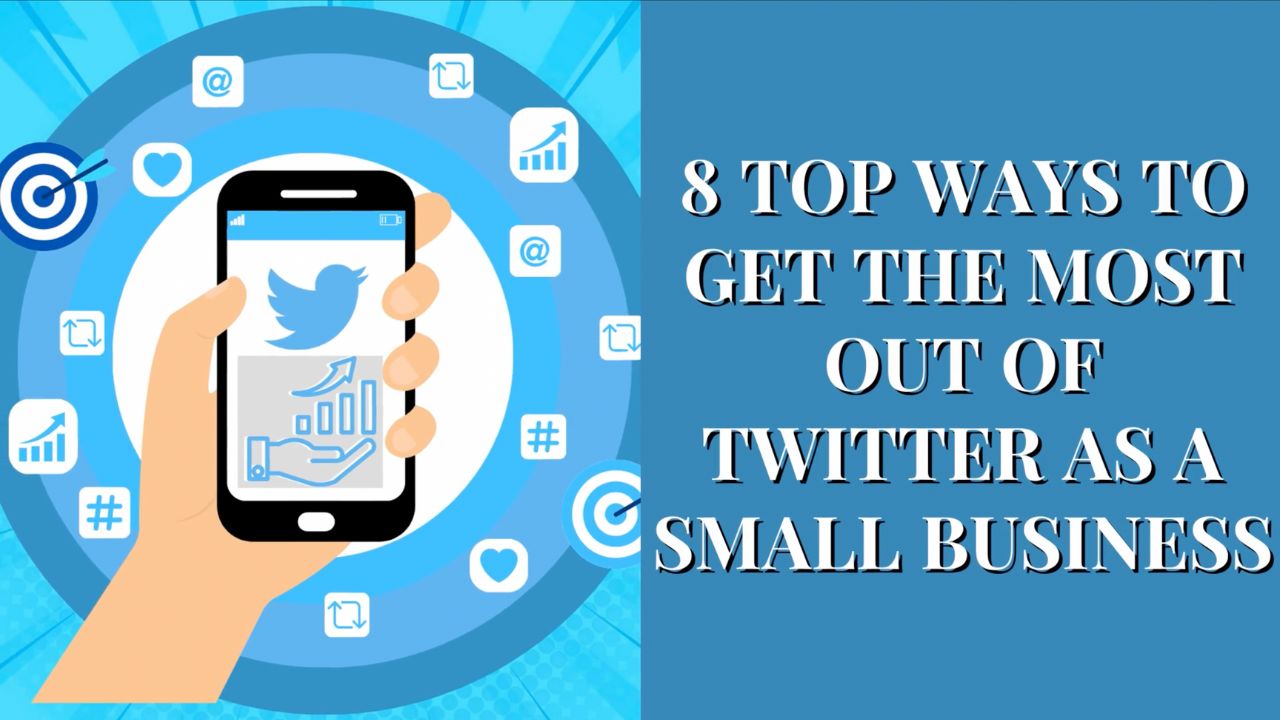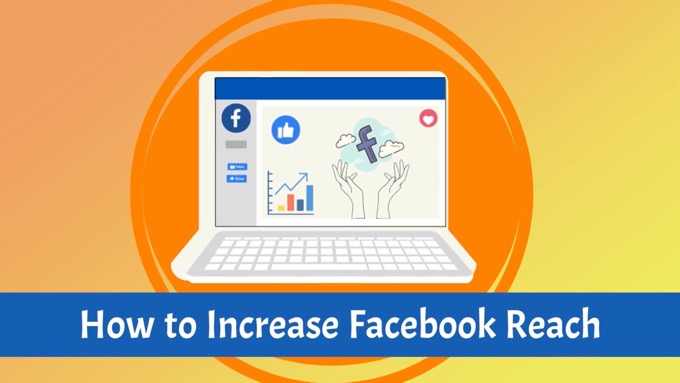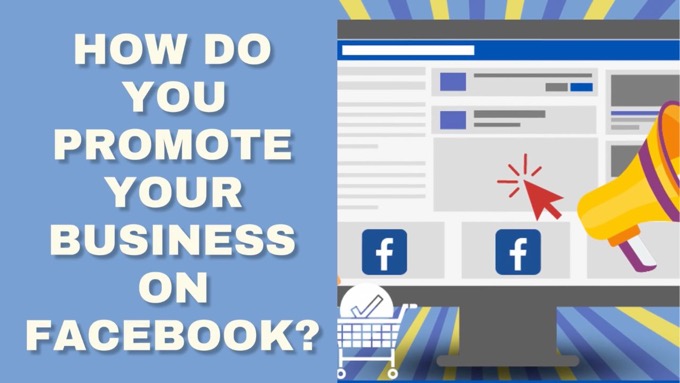X is one of the largest social platforms with millions of users, and as such can be a powerful tool to:
- Reach your marketplace
- Attract leads
- Build relationships with people who can accelerate your success.
So how should you approach it?
That’s what you’re about to find out, with 8 top ways to maximize X as a small business…
8 Ways to Maximize X for Your Small Business
1. Create a Strong X Profile
If you want X users to follow you, connect with you, and engage in other ways, a strong profile is essential. There are six main elements involved as follows:
A. Your X Handle
Your handle on X is your username, starting with the “@” symbol.
For example, ours is @EverywhereMktr.
It should be a clear reflection of your business and brand, and is shown (in full or part) at the top of all your posts.

If the handle reflecting the exact name of your business is not available, try varying it in some way such as by:
- Abbreviating one of the words in your business’s name…
- Including your location if you’re a local business…
- Adding a word that reflects your niche
Avoid using random numbers or letters in the handle as it generally lacks authority and credibility.
B. Your Profile Pic
The profile picture is the smaller image shown at the top of your X profile, overlapping the bottom of your header image, and is what accompanies your posts, visually representing your brand.
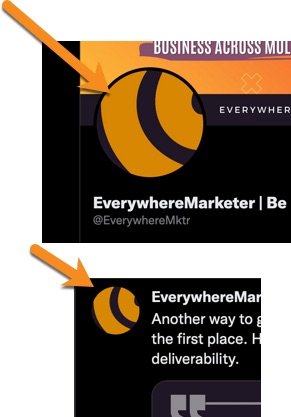
Use a logo or appropriate professional image, preferably sized to 400 x 400 pixels.
For a small business profile, it should look professional and be distinct enough for people to start visually associating it with your business.
C. Your Header Image
This is what shows right at the top of your profile, and again should represent your brand in a professional, positive way.
Size the header image to 1500 pixels wide by 500 pixels tall.
D. Your Profile Name
This should reflect the name of your business or brand.
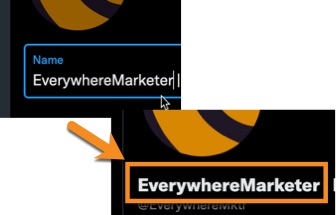
E. Your Bio
The bio is the couple of lines that appears beneath the handle on your X profile page.
Your bio should be clear and compelling, reflecting what you do as a business and the type of followers you want to attract. And don’t forget to include a link back to your website!
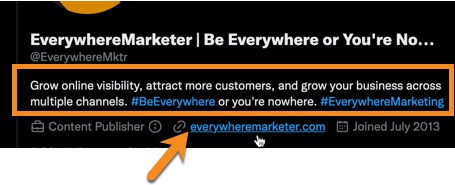
F. Your Followers
Yes, like it or not, the number of followers you have helps determine the amount of credibility, trust and authority — in other words, “social proof” — you are afforded by other X users. The more followers you have, the easier it tends to be to attract others.
It’s not of course an overnight fix, and is instead something to work on over time. Watch this quick summary to find out how, or view the full guide:
2. Share Valuable Content
WIth your profile all sorted, you can now think about what to actually post.
Businesses often struggle with knowing what to post on social media, but, regardless of platform, what users are looking for is content that:
- Engages them
- Provides value
Typical advice given to businesses is generally vague, such as to:
- “Share industry news” — the only problem is, in a lot of niches, this might interest others in your industry, but not your customers; they’re far more interested in content that affects or can help them…
- “Share tips” — works better in some niches than others, and still leaves businesses with an endless cycle of wondering what to post next
So what can you do instead?
It’s far better to put in place a systemized process that:
- Means you have an endless supply of content to post out (as well as post on other social platforms) that’s of interest to your audience…
- Can be easily delegated.
In a nutshell, it involves:
- Creating regular pillar content—this is long- or medium-format content published at least once a week, such as a blog, podcast or YouTube channel.
- Repurposing that content into different formats for different platforms, including (but not limited to) X.
“It’s an infinite content engine… whatever brand you are, produce long-form or even medium-form content and then divvy it up.”
Chris Williamson, Modern Wisdom podcast (source)
It starts with getting the right workflow in place. After that, it can just run like clockwork. Here’s the full guide: The Ultimate Repurposing Workflow for Your Business
3. Post Regularly and Consistently
What the above repurposing workflow helps with too is ensuring that you’re able to post to your social media channels and elsewhere, regularly and consistently.
It’s no different on X.
You’ve got to keep showing up, or you essentially “don’t exist”.
It’s how you keep appearing in people’s feeds, they get “touched” multiple times, the relationship grows, they increasingly build a sense of trust, and at some point may even become a customer.
And for those considering making a purchase, one of the first places potential customers look to assess your credibility is your social media channels.
Are you active regularly and consistently?
If so, it helps build trust in the prospect’s mind and they’re more likely to purchase from you.
If not, they may wonder whether you’re even still in business, will doubt your ability to deliver, and are more likely to look elsewhere to purchase what they’re looking for.
On X, as on other social platforms, your business has to keep showing up or you essentially "don't exist". Are you active, regularly and consistently?Click To Post On4. Engage with Your Audience
Remember that social media is not just a broadcast chamber, but also meant to be “social”—and X in particular is focused on conversation and (often lively) debate.
So be prepared to engage with your audience, such as:
- Responding to ‘mentions’ (in other words, when your X handle is included in another post on the platform)—one way to do this is to repost or like it, where appropriate…
- Replying to direct messages…
- Using X polls to survey your audience…

- Proactively interact and engage with other posts that would be of interest to your audience, including reposting, replying and liking.
5. Use Hashtags
The effectiveness of hashtags on X is in decline, particularly as the algorithm no longer needs them to surface your content.
But they are still used.
For example, users interested in a particular topic can click on a particular hashtag to see other related content.
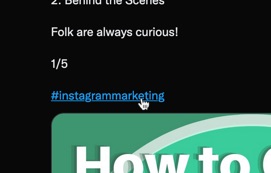
And using a particular hashtag, can signal that you're contributing to a specific conversation (such as relating to a company event).
Hashtags also appear in X’s search results.
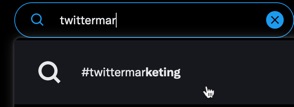
As well as general discoverability, hashtags serve to give an immediate indication about a post’s topic, helping to attract your intended audience when scrolling through feeds.
So while you no longer have to (or even should) use them every time, remember to use them where they add value or might encourage community participation.
6. Build Relationships
We’ve already mentioned engaging with your audience, but this can become even more beneficial when you purposefully use X as a platform through which to build relationships with:
- Prospects and customers…
- Influencers—for example, think about who the key players are in your industry and that your customers are influenced by. Follow them and support them by engaging with their content on a regular basis. Look for opportunities to help them outside the platform too. Over time, this can build powerful relationships that can prove very beneficial for your own small business…
- Related businesses—this can lead to opportunities such as joint ventures, speaking opportunities, and more
7. Use X’s Analytics
Basic stats are shown at the bottom of posts, such as likes and view counts.

More in-depth analytics are available to Premium subscribers on the platform.
By keeping an eye on your metrics, you start to get a feel for what’s working and what’s not, and can improve your performance on X accordingly.
Maximize the benefits of X for your small business by using their analytics (via Premium). Keep an eye on what's working and what's not, and adjust accordingly.Click To Post On8. Use X Ads
Finally, don’t forget about advertising on X, which has some advantages such as:
- Paying for performance—such as per-click, rather than CPM (although that’s also an option)...
- Lower ad costs—ad costs on X can be significantly cheaper than on other networks…
- Targeting of custom audiences—such as visitors who have taken a particular action on your website…
- Targeting of keyword-based interests—in other words, target people based on posts they’ve sent or engaged with, and what they’ve searched for
For example, try using promoted posts for general-purpose advertising.
There’s a full guide on how to use X ads available here, but as a quick summary:
- Create your X ads account.
- Choose your ads objective.
- Enter your campaign details.
- Enter details for your ad group, such as placement and targeting info.
- Create your ads.
- Review and launch your campaign.
Frequently Asked Questions
How can I create a strong X profile for my small business?
Ensure key elements like handle, profile pic, header image, name, bio, and followers reflect your brand appropriately.
What content should I post on X for my small business?
Share valuable, engaging content regularly; focus on systemized content creation and repurposing for optimal results.
Why is it important to engage with my audience on X?
Engagement builds relationships, fosters conversations, and boosts credibility, leading to increased trust and potential conversions for your business.
Should I use hashtags on X for my small business?
While their effectiveness has decreased, use hashtags strategically to improve discoverability, signal topics, and encourage community engagement.
How can X analytics benefit my small business?
Utilize X's analytics to understand performance, optimize strategies, and make data-driven decisions to enhance your presence on the platform.
To Conclude
Don’t expect overnight success on X.
Like any other social platform, getting results, including attracting an authentic audience of followers, is a long-term play that requires perseverance, dedication and patience.
So start wherever you’re at, and give your presence on X time to grow from there. Most importantly, keep showing up with regular and consistent activity, and simply aim to steadily improve over time.
